Eastern Barred Bandicoot re-introduction - Churchill Island & Phillip Island
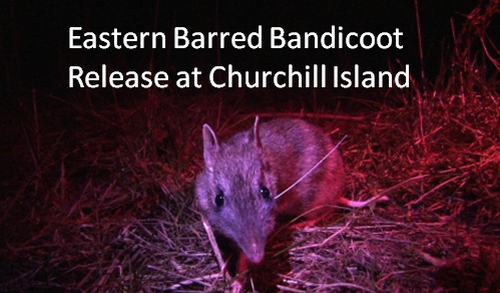
Image: Zoos Victoria
- Release updates
- Update 1 - 16 August 2015 (release)
- Update 2 - 1 September 2015
- Update 3 - 25 September 2015
- Update 4 - 11 November 2015
- Update 5 - 10 February 2016
- Update 6 - 14 April 2016
- Update 7 - 15 June 2016
- Update 8 - 22 September 2016
- Update 9 - 14 December 2016
- Update 10 - 10 March 2017
- Update 11 - 30 June 2017
- Update 12 - 27 October 2017 (Includes new release at Phillip Island)
- Update 13 - 14 November 2017 (Phillip Island update)
- Update 14 - 8 December 2017 (Phillip Island update)
- Update 15 - 21 February 2018 (Phillip Island update)
- Update 16 - 16 March 218 (Churchill Island)
- Update 17 - May 2018 (Phillip Island)
- Update 18 - September 2018 (Phillip Island)
- Update 19 - March 2019 (Phillip Island)
- Update 20 - September 2019 (Churchill Island)
- Update 21 - March 2020 (Churchill Island & Phillip Island)
- Update 22 - October 2020 (Churchill Island & Phillip Island)
- Update 23 - June 2025 (Churchill Island & Phillip Island)
- More information
Updates on the Churchill Island Eastern Barred Bandicoot release are adapted from information provided by Dr Duncan Sutherland, Senior Research Scientist, Deputy Research Manager - Phillip Island Nature Parks.
Update No.1 Release
On Sunday 16th August 2015, Zoos Victoria in conjunction with the Eastern Barred Bandicoot Recovery Team released 16 Eastern Barred Bandicoots (8 males and 8 females) onto Churchill Island, near Phillip Island.
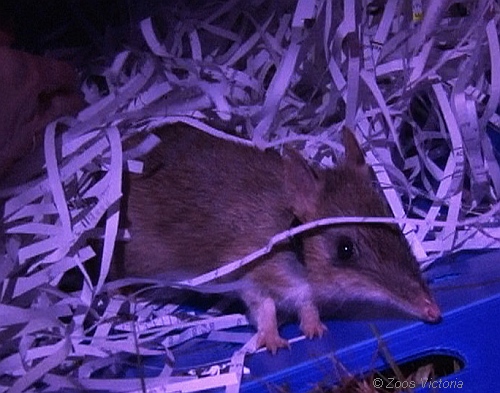
All 16 EBB's have been radio tracked during their first week after release. All individuals have moved day-time nesting sites several times and have been observed moving about foraging freely at night. The map indicates where the Bandicoots have been found. Numbers 1 to 8 are captive animals from Zoos Victoria and 9 to 16 all come from Mt Rothwell.
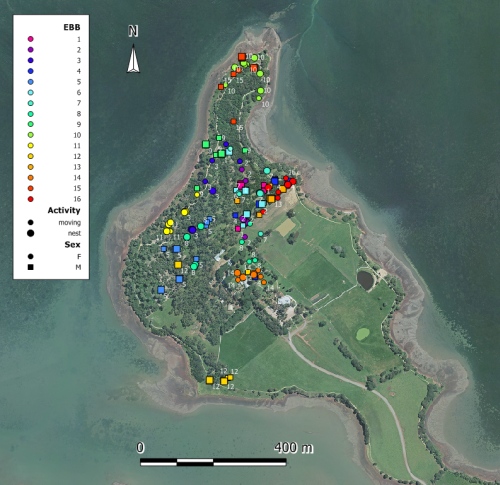
Update No. 2, 1st September 2015 - (2 weeks post release)
There has been daily radio-tracking of each animal and trapping to monitor their health and condition.
The bandicoots have been moving around, changing nest locations and seen foraging in pretty much every habitat available to them. There was even an observation of a couple of pairs mating. See their movements across the island since they were released in the map below.
Unfortunately, on Wednesday night the first mortality was found, a female that was part of the captive population bred at Melbourne Zoo. A post mortem conducted by the Melbourne Zoo Vet Department revealed that the cause of death was due to dramatic weight loss and severe dehydration. These events are always unfortunate, but are a reality for animals adapting to living in the wild.
Of the remaining 15 Bandicoots on Churchill Island, the team has been able to successfully trap 11 and all are doing well. The other four are being tracked and have been seen moving around freely.
The majority of captive bred EBBs have recorded some weight loss which is to be expected in the first two weeks after release, though one has put on weight. In comparison, the semi-wild EBBs from Mt Rothwell have all put on weight. Churchill Island life seems to agree with them!
A Mt Rothwell female was trapped and found to be carrying two large pouch young. Another female which has not been trapped yet looks to be carrying pouch young as well.
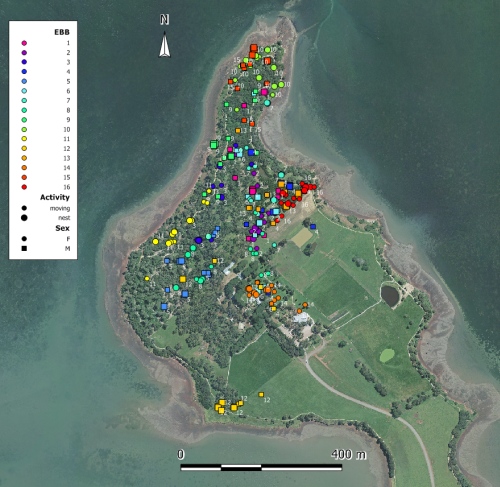
Update No. 3, 25 September 2015 - (6 weeks post release)
Updates on the Churchill Island Eastern Barred Bandicoot release are adapted from information provided by Dr Duncan Sutherland, Senior Research Scientist, Deputy Research Manager - Phillip Island Nature Parks.
Radio-tracking of the bandicoots has continued over the last month. The bandicoots have started to explore more of the island, in some cases trekking from one end of the island to the other. Nests have now been found from the north tip to the south. The radio collars have provided great insights into the movements of the bandicoots as they establish themselves in their new home.
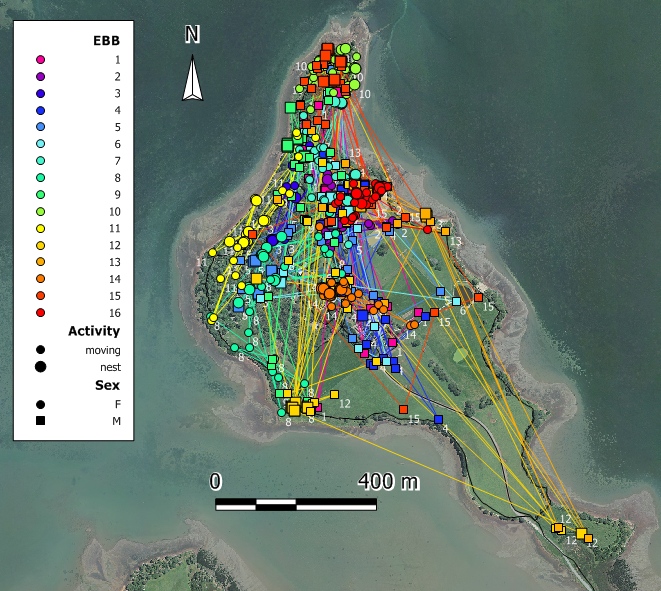
Trapping has shown that most of the bandicoots have gained weight since their release and are in very good condition. All three females translocated with pouch young kept their young, some are already young at foot running around and foraging with their mum, plus we have 12 pouch young that originate from Churchill Island. There are plenty of healthy babies on the way!
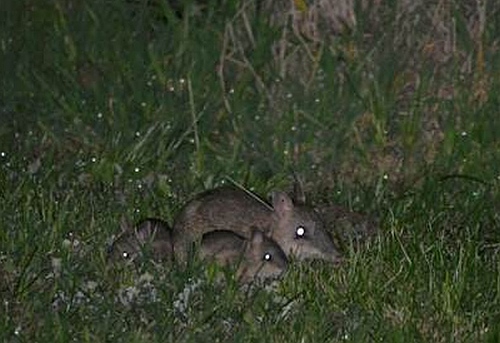
Eastern Barred Bandicoot on Churchill Island with young at foot.
Tracking collars have been temporarily removed from all the bandicoots to avoid entanglement and will be replaced with a modified design to allow them to break-away in the event of a leg entanglement.
In summary, the population is going extremely well; the bandicoots have made a successful transition to Churchill Island, have put on weight, are exploring most corners of the island and are breeding happily!
The next update will be late October when the next round of trapping takes place.
Update No. 4, 11 November 2015 - (13 weeks post release)
The Eastern Barred Bandicoots continue to do well on Churchill Island.
The planned release of Eastern Barred Bandicoots to Churchill Island for 2015 was completed on 16 October 2015. In all 20 Eastern Barred Bandicoots were released onto Churchill Is. in 2015; 8 from Zoos Vic. captive populations and 12 from Mt Rothwell.
The last 4 were translocated from Mt Rothwell, all females without pouched young to even up the sex ratio of those already released onto Churchill Island.
Results from recent trapping in late October
All but one of the females initially released onto Churchill were trapped and all had pouch young. Of these young, 7 were large, furred and soon to be young at foot. They’re the first wild born bandicoots on Churchill Island!
Overall, 14 bandicoots were trapped and were in very good body condition, all having gained weight since release. One of these was a sub-adult male who was originally translocated in-pouch from Mt. Rothwell. He had tripled his weight in just over a month since last being weighed. Another generation of Churchill Island bandicoots may not be too far away.
Update No. 5, 10 February 2016 - (26 weeks post release)
The Eastern Barred Bandicoot population continues to grow and establish itself on Churchill Island.
- Monitoring was conducted in late December 2015 and the end of January 2016.
- In January the team had 59 captures of 23 different individual EBBs over the 4 nights of monitoring.
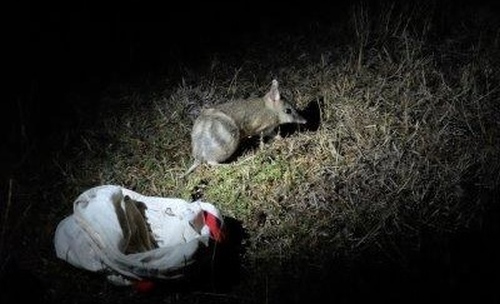
In this project so far the team have captured 7 bandicoots that were born on Churchill Island and have joined the trappable population; one of these new animals in January was a female carrying 2 pouch young of her own. So, the third generation has arrived!
Update No. 6, 14 April 2016 (34 weeks post release)
The Eastern Barred Bandicoot team on Churchill Island recently completed another successful round of Eastern Barred Bandicoot monitoring at Churchill Island. Eight months on, the population continues to grow steadily. In all 30 different individuals were captured, 5 of which had not been captured before this session. The majority of the original founder animals continue to be seen and most of the females captured were with 1 or 2 pouch young. Conditions on the island have stayed good enough over this dry summer that the bandicoots have remained healthy, are breeding and fresh little diggings can be found across all corners of the island.
Update No. 7, 15 June 2016 (43 weeks post release)
Results from the June monitoring program found the population has continued to grow with 101 captures of 40 different individuals. This is up from a total of 30 different individuals back in April. The Eastern Barred Bandicoots captured were in good condition and most of the females were carrying pouch young.
The good news is also that 10 months after their release, three quarters of the original founding individuals were recaptured, indicating survival rates are high on the island.
The next monitoring session on Churchill Island will be in August 2016 which will mark the first anniversary of this trial release.
Update No. 8, 23 September 2016 (1 year and 10 weeks post release)
Results from the Eastern Barred Bandicoot monitoring on Churchill Island in August 2016. All up there were 58 different individuals captured, nearly twice as many as were seen in April, plus 37 unique pouch young.
This indicates a good breeding season and a great result for the bandicoot population.
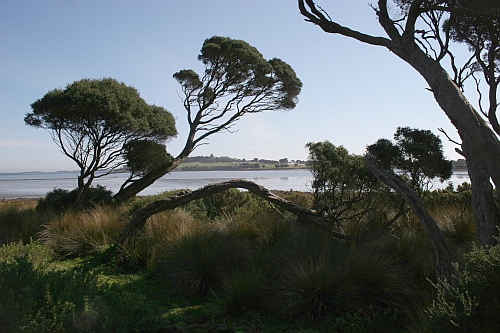
Update No. 9, 14 December 2016 (1 year and 4 months post release)
Results from the Eastern Barred Bandicoot monitoring on Churchill Island in December 2016. It is three months since the last Eastern Barred Bandicoot trapping session on Churchill Island and the population has grown further, with 71 unique individuals, 27 of whom had not been captured before. This is up from 58 unique individuals captured back in September. The team also noted that as they work across the island they see plenty of young at foot which are not entering the traps.
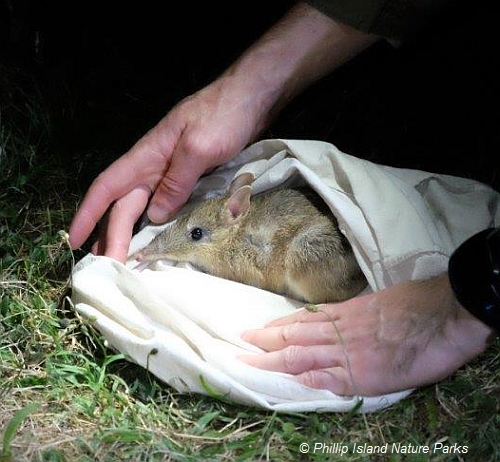
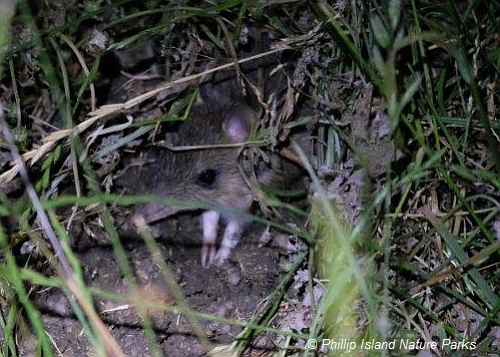
Interestingly, only a few of the captured females were breeding, and body condition of the bandicoots was generally lower than in previous sessions, the sort of signs the team might expect if the population were reaching its carrying capacity on the island.
Update No. 10, 10th March 2017
Results from the Eastern Barred Bandicoot monitoring on Churchill Island during the week ending 10th March 2017. The number of unique bandicoots captured reached an impressive 100 individuals, up from 71 last December. More than 40 were captured for the first time during this session. This means another rise in the population size. The interesting development, though, is that breeding seems to have halted; the team encountered no pouch young. Breeding in EBBs is usually depressed at this time of year, but this is a clear indications that the population size growth rate has slowed. This slowing in population size growth rate is expected, but encouraging to see – especially when it’s not driven by predation.
With more captures more teams and more volunteer helpers took part. Duncan extends a big thank you to everyone who helped out and witnessed the bandicoots flourishing on Churchill Island.
Update No. 11, 30 June 2017
The Eastern Barred Bandicoot team on Churchill Island completed another trapping session in mid-June to monitor the population. The results are very pleasing with lots of bandicoot diggings to be found across the island.
Breeding had recommenced with all females carrying pouch young. This was in stark contrast to the complete absence of any pouch young back in March. Of particular note was the capture of almost the same number of unique individuals in June (101) as in March (98), suggesting a stabilising of population density.
The team came across some of the original founding animals, all which are at least 2 years old now and considered very good for an Eastern Barred Bandicoot in the wild.
Update No. 12, 27 October 2017 (Includes new release at Phillip Island)
Eastern Barred Bandicoot history was made on Friday 20 October 2017 in a momentous step in the recovery of the Eastern Barred Bandicoot by releasing 44 EBB’s into the wild on the Summerland Peninsula, Phillip Island. This has been made possible by the recent declaration that Phillip Island is now fox-free (a momentous achievement in itself) and by the hard work of the Eastern Barred Bandicoot Recovery Team including all its members.
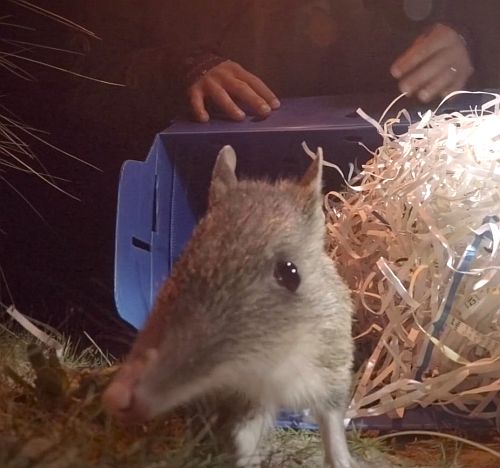
On the night, many of the project partners, local members of our Aboriginal and Torre Strait Islander community, and members of the EBB Recovery Team all gathered to release the animals and celebrate this enormous milestone for the long-term survival of the EBBs.
The release at Phillip Island is based on the success of the trail releases of 20 EBBs on Churchill Island in 2015. Over the last two years this population has increased to 120 individuals.
Eastern Barred Bandicoot release at Phillip Island, 20 October 2017 – Zoos Victoria.
Phillip Island monitoring
Early monitoring results from Phillip Island so far indicate that all 30 of the 44 animals with transmitters attached to their tail have been relocated and are nesting not far their point of release.
Key partnerships made this possible
This project to save the EBBs is an extraordinary example of successful partnerships, with the EBB Recovery Team comprised of representatives from: Conservation Volunteers Australia, Department of Environment, Land, Water and Planning (DELWP), Mt Rothwell Biodiversity Interpretation Centre, National Trust of Australia, Parks Victoria, Phillip Island Nature Parks, the University of Melbourne, Tiverton Property Partnering and Zoos Victoria. Generous funding support provided by the Helen Macpherson Smith Trust, the Ian Potter Foundation and Penguin Foundation (for the Fox Eradication Program) also made this release possible.
See also: Zoos Victoria - Full news release
Update 13, 14 November 2017 (inc. Phillip Island release update)
The Eastern Barred Bandicoot team had a successful catch at Churchill Island last week to collect the remaining EBBs coming from there for release to Summerland Peninsula, Phillip Island. In all they trapped 64 and collected 11 females and 6 males for translocation, bringing the total to 20 males and 20 females from Churchill Island and 61 individuals released to Summerlands so far. There are still plans to catch some at Hamilton Community Parklands in the future.
The radiotracking of 30 bandicoots following their release has concluded. The transmitters began falling off the tails of bandicoots after about 1 week. Importantly, no known mortality related to feral cats were detected immediately after release. All of the animals have stayed pretty close to their release site. (see the map below).
![]()
Locations of EBB nests from daytime radiotracking fixes (yellow) in the first 2 weeks at Phillip Island; release sites (blue). For scale, the map spans almost 2 km east to west. Source: Phillip Island Nature Parks. The release site is a reclaimed housing estate that has been fully restored to be habitat for wildlife including penguins, shearwaters, wallabies, Cape Barren geese and now eastern barred bandicoots.
The first monitoring session with live trapping of EBBs on Summerland Peninsula was conducted on 13 November 2017. In all, 22 bandicoots were trapped, 13 were sent to our vet team that were out in the field with us where they were tested to see if they have been exposed to the disease Toxoplasmosis (a disease spread in the faeces of feral cats).
Encouragingly, of the 12 females captured 5 had tiny pouch young that must have been conceived on Summerland Peninsula. The good body condition and weight of all the animals also suggests conditions are suiting them in their new home.
Update 14, 8 December 2017 (inc. Phillip Island release update)
On Wednesday 6 December an additional release of 6 Eastern Barred Bandicoots was carried out at Summerland Peninsula, Phillip Island. These animals (5 males and 1 female) were moved from the Hamilton population and along the way received a vet check and Toxoplasmosis disease screening at Melbourne Zoo. This brings the total number of Eastern Barred Bandicoots released on Phillip Island to 67 individuals.
During a three-night trapping session last month 36 of the possible 60 individuals were trapped and released. There has only been one confirmed death since the initial release in October, though it is hard now to detect any mortalities without the transmitters. The next monitoring session is planned for February.
Bandicoot diggings can now be readily found on the peninsula, which is a return of the important ecological function that had been lost on the island with the local extinction of species like potoroos and bandicoots, and is helping to restore the compacted soils in the old housing estate. This is another step in the restoration of this special landscape.
The latest release was made possible through the EBB Recovery Team, DELWP, Conservation Volunteers Australia, Zoos Victoria vet team and Phillip Island Nature Parks.
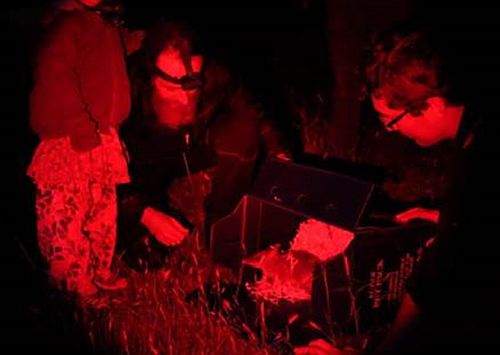
An Eastern Barred Bandicoot being released on Summerland Peninsula, Phillip Island, December 2017. Image: Phillip Island Nature Parks
Update 15 - 21 February 2018 (Phillip Island update)
The team from Phillip Island Nature Parks, Zoos Victoria and volunteers recently carried out monitoring of Eastern Barred Bandicoots at Summerland Peninsula, Phillip Island. The monitoring was done to check the condition of the Bandicoots which had been released during October, November and December last year. It’s been 3 months since the last trapping session and the team were keen to see how they’ve fared in their new home.
In three nights 32 different individuals were caught – a similar number to the monitoring in November (36) – but interestingly, more females (20) than males (12). Usually it’s the other way around. The animals were in normal body condition, but the very encouraging news is that most females were breeding, only a couple didn’t have pouch young or young in the nest. In contrast, at Churchill Island no females were found breeding at this time which indicates conditions must be good for the bandicoots on Summerland Peninsula.
Again, the team of Zoos Victoria vets took blood samples from bandicoots to test for the disease, Toxoplasmosis. This is a disease that is spread by feral cats and is known to kill bandicoots.
Radio-transmitters were attached to the tails of 24 bandicoots to see where they move over the next 2 weeks and, if they die during that time, to determine the cause of death.
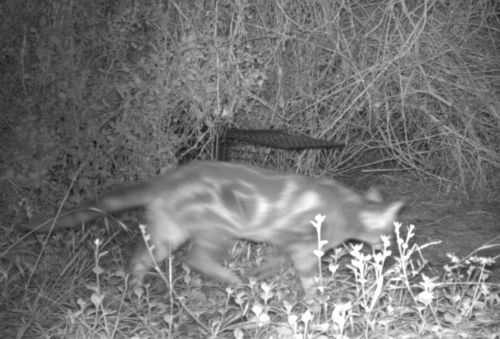
Camera traps have detected at least 3 feral cats in the area, along with bandicoots in the same location, so the bandicoot population appears to be surviving in the presence of some feral cats.
The next trapping session on Summerland Peninsula is due in May when we might start to see some of the young bandicoots entering traps themselves.
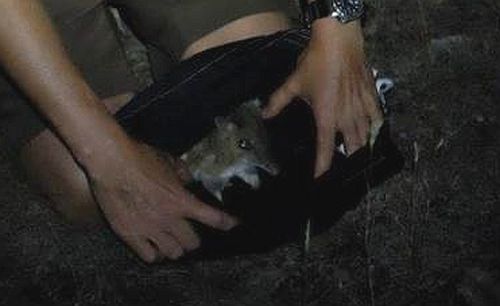
Eastern Barred Bandicoot being released during monitoring on Phillip Island. Source: Phillip Island Nature Parks.
Update 16, 16 March 2018 (Churchill Island)
Monitoring was conducted at Churchill Island during the second week in March 2018. The previous trapping was 5 months ago when 40 animals were captured for release to Phillip Island. Another 5 were caught for the captive breeding program during January and February. The Team found previous collections did not have a noticeable impact on the Churchill Island population.
The Team found very few empty traps; they captured 99 different individuals on 179 occasions over the 4 nights – much the same as they were getting before the collections. Males outnumbered the females again, there was no sign of breeding (which is normal for this time of year) and body condition was fair. The population continues to do well, and to top it all off they caught five of the original founders 2½ years after their initial release to Churchill Island!
Trial of unique tagging system
An array of camera traps is set across the island to monitor the bandicoot population and to keep an eye on any foxes, cats or rabbits should they make it through our defenses. Unfortunately, the bandicoots can’t be individually identified from the cameras (their stripes are not bar codes) which would make estimating their number much easier. So, it’s impossible to tell if a camera is recording lots of different bandicoots or just one bandicoot lots of times. However, this session Bec Groenewegen started a trial for her PhD by placing a unique tag on 48 individuals that can be seen on the cameras (see photo below). We’re hoping this will allow us to determine how detectable the different individual bandicoots are on cameras and maybe we can build some fancy mathematical models to estimate bandicoot numbers reliably with just cameras.
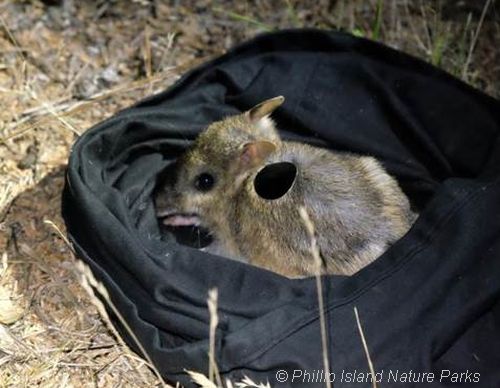
A reflective tag glued to an Eastern Barred Bandicoot on Churchill Island. The tag reflects a unique number under infrared light emitted from the camera traps.
Update 17 - May 2018 (Phillip Island)
The Phillip Island population was founded with 67 individuals, starting with 44 in October, 17 in November and 6 in December. It has now been trapped in November 2017, February 2018 and now May 2018. This newly establishing population still appears to be doing well. In each trapping session the team captured 36, 32 and 38 unique individuals respectively, only two of which have been cleanskins (born and bred on Phillip Island). That’s 53 of the 67 founders that have now been re-trapped. The population has also spread from the release sites and the trapping grid – there are diggings and sightings (observed and on cameras) at least a kilometre from the nearest release point. Meanwhile, since their release in October 2017 there have been 20 feral cats removed from the Summerland Peninsula area, most on the buffer line.
Breeding
Almost all female bandicoots were breeding in each session (unlike at Churchill Island) and there have been lots of sightings of young at foot. The body condition of animals has been excellent and some have been over 1 kg in weight. During each trapping session, and at the initial release, the Zoos Victoria vet team have bled bandicoots to screen them for Toxoplasmosis, which is disease spread by feral cats. None of the EBBs were positive at release, and none have returned positive so far from the individuals re-tested (26 were tested in May). Either they aren’t contracting the disease, or we never see them again if they do.
Radio trackers
Each trapping session the team have also fitted individuals with radio-trackers on their tail to monitor survival for up to 2 weeks, plus they help monitor their spread and identify habitat use. There have been only three confirmed deaths so far, one male who tragically fell into a disused septic tank and couldn’t escape, one roadkill, and one juvenile observed being taken by an unidentified owl.
Volunteers
Again, a small army of volunteers has been invaluable to help monitor this population, both while checking traps and tracking down the radio-transmitters. The radio-tracking was a Zoos Victoria fellowship project carried out brilliantly by Jacinda Goodwin. We’ve been generously supported by the Helen Macpherson Smith Trust, the Penguin Foundation, Zoos Victoria and Matthew Godson. A huge thanks to everyone!
Update 18 - September 2018 (Phillip Island)
Earlier this month a team of 31 staff and volunteers revisited Summerland Peninsula, Phillip Island, to monitor the eastern barred bandicoot population that was released there last October. The last five months has been a critical time when the bandicoot population has been establishing in the presence of feral cats, but when short tailed shearwaters, an abundant alternative food supply for feral cats in the summer months, have been absent. In three nights, 42 unique adults were captured, more than in any previous session, including 11 new individuals that originate from Phillip Island. The animals were big, healthy and breeding well.
So, after 11 months on Summerland Peninsula, the bandicoot population has grown in the presence of feral cats and spread beyond the release area. In that time, 32 feral cats have been removed from the Peninsula which is a credit to the pest animal team.
The results so far, a credit to the dedicated team of staff and volunteers that have helped to recover the mainland Eastern Barred Bandicoot.
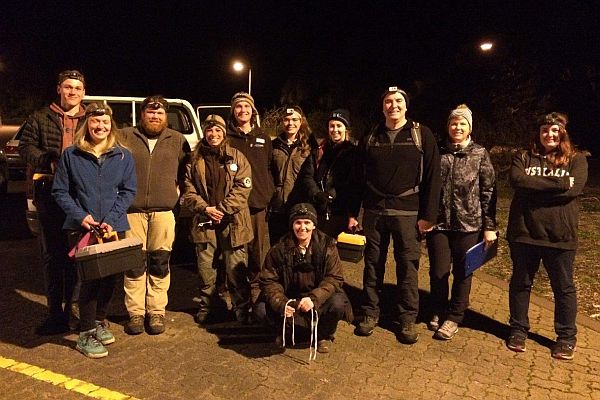
Phillip Island Nature Parks staff and volunteers preparing to head out to monitor Eastern Barred Bandicoots on Phillip Island. In September 2018, 24 volunteers donatied 246 hours towards the monitoring and conservation of this species.
Update 19, March 2019 (Phillip Island)
During the first week of March 2019, the Eastern Barred Bandicoot team carried out monitoring at Summerland Peninsula on Phillip Island. This monitoring was carried out 17 months since Eastern Barred Bandicoots were released into the area.
Over three nights the team captured 35 different individuals (18 females and 17 males) including 15 that were born on Phillip Island, captured for the first time. The animals were in really good condition, though none of the females were breeding this time.
As with previous monitoring, two teams of vets from Zoos Victoria collected blood samples to understand the impact of the disease, toxoplasmosis, that is spread in the environment by cats and is known to be lethal to bandicoots. During this monitoring 22 bandicoots were screened for disease, (results not available yet). None of the blood samples tested from the earlier trapping sessions have been positive for the toxoplasmosis, though one individual bandicoot that was struck by a vehicle looks like it had been infected. If confirmed it would be the first record so far.
Summary
The population is going strong, despite the presence of feral cats. Furthermore, recent mapping of bandicoot digging activity across the peninsula shows that the population has now spread across the entire peninsula.
The efforts from volunteers and Zoos Victoria vets is fundamental to the success of the project. Duncan acknowledges and thanks those involved, especially the 30 different volunteers who donated 186 hours in just 3 days to help see this species flourishing in the wild.
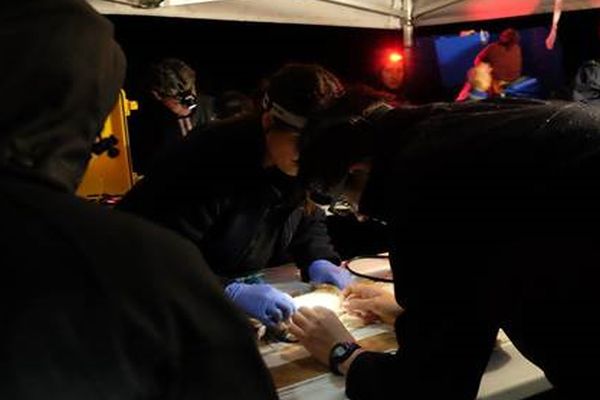
Phillip Island Nature Parks staff and volunteers delivering eastern barred bandicoots to Zoos Victoria vet teams at a field station on Summerland Peninsula.
Update 20, September 2019
During the last week of August, the Eastern Barred Bandicoot team from Phillip Island Nature Parks undertook monitoring of the Churchill Island population which was established 4 years ago (Update 1).
The Churchill Island population continues to do well. All adult females were breeding, most with 2 or 3 large pouch young. Over the 3 nights there were 71 unique individuals captured on Churchill Island, slightly more than in March this year and similar to the numbers this time last year. Of those captured, 18 were seen for the first time.
Monitoring was also conducted at in an adjacent area on Phillip Island at Fishers Wetland, to see what was happening with the bandicoots that have made their own way from Churchill Island.
At Fishers Wetland the team managed to capture 25 unique individuals, all of which were captured for the first time. They showed a similar pattern of breeding to those on Churchill Island; an encouraging sign. This population is persisting and breeding, despite being in the presence of feral cats.
The monitoring was a fabulous effort from all the dedicated volunteers which enabled the team to successfully monitor both sites at the same time.
Update 21, March 2020
Release of Eastern Barred Bandicoots on French Island
The first release of Eastern Barred Bandicoots at French Island was undertaken on 11 October 2019, a with the release of 56 bandicoots, 40 of which were sourced from the Churchill Island population which was established in 2015 (Update 1). The release on Frech Island is a joint project with Zoos Victoria, Parks Victoria, the French Island community and Phillip Island Nature Parks.
Eastern Barred Bandicoot Autumn monitoring 2020
Monitoring of Eastern Barred Bandicoot populations was carried out during March at the following locations;
- Churchill Island
- Fishers Wetland on Phillip Island adjacent to Churchill Island
- Summerland Peninsula at the western tip of Phillip Island
Over three nights 66 individuals were caught on Churchill Island and 17 individuals in Fishers Wetland - 42 of which were cleanskins. The populations continue to do well. The number of individuals is similar to the last monitoring in September which indicates that there has been a good recovery on Churchill Island after 40 adults were collected for release to French island in October.
At Summerland Peninsula, 40 individuals were caught (17 males and 23 females), of which 18 were new animals. This is a few more than previous sessions. Overall, individuals appeared to be really healthy body condition and very few had obvious ectoparasites. The team also caught 6 of the original founders, still surviving 2½ years since their release.
The monitoring was a fabulous effort considering more stringent COVID-19 restrictions were in force towards the last week of monitoring which meant volunteers and external partners couldn’t participate.
Update 22, October 2020
Eastern Barred Bandicoot – Spring monitoring 2020
Churchill Island
The population has been there for 5 years now and continues to go strong. There were 79 unique individuals captured (27 females, 52 males), 30 of which hadn’t been seen before. This is 13 more individuals than at the last visit in March. Most females had pouch young, which is normal for this time of year, and there were lots of young bandicoots seen running around as we walked between traps.
Fishers Wetland, just off Churchill Island.
This is known to be a small population; a total of 13 unique individuals were caught (3 females, 10 males), 5 of which were new. All of these females were breeding and had 2 or 3 large pouch young.
Summerland Peninsula – Phillip Island
The population is now in its 3rd year and has expanded from the peninsula onto the greater Phillip Island, spreading as far as Kitty Miller Bay to the east, and McHaffies Lane to the North, and is looking well established now. 46 unique individuals were captured (26 females, 20 males), of which 21 hadn’t been seen before. This is a few more unique individuals than the last few sessions despite the fact that fewer traps were used. Breeding was similar to that on Churchill Island except that quite a few of the pouch young were huge and on the verge of leaving the pouch.
Thanks!
A big shout out to the amazing team of Nature Parks deployment staff, as well as a couple of friends from Parks Victoria, who braved the weather and late nights so we can ensure the recovery of this species.
Updates on the Churchill Island Eastern Barred Bandicoot release are adapted from information provided by Dr Duncan Sutherland, Senior Research Scientist, Deputy Research Manager - Phillip Island Nature Parks.
Update 23, June 2025
This update summarises the progress of the Eastern Barred Bandicoot populations at the release sites on Churchill Island and Phillip Island since 2020.
Over the past 5 years there has been on-going monitoring of the Eastern Barred Bandicoot populations at release sites. The overall trend has been a significant increase in bandicoot numbers at each site and expansion across adjoining areas of Phillip Island.
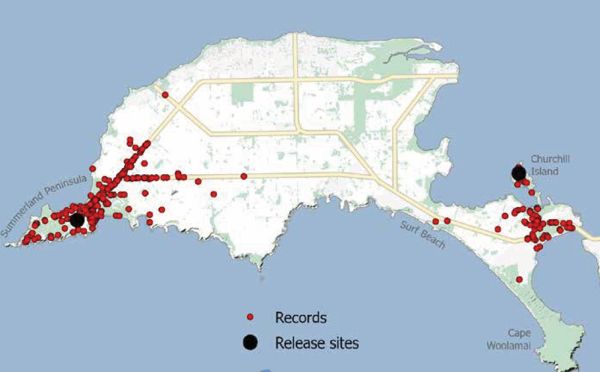
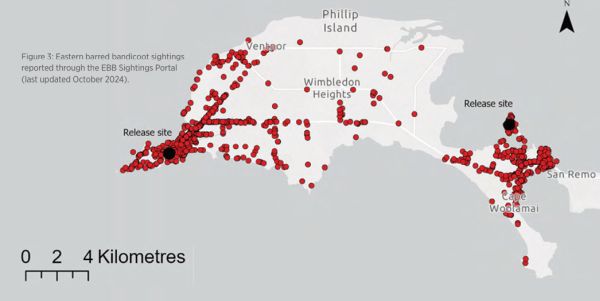
The above maps indicate an expansion of Eastern Barred Bandicoots from the original release sites. Phillip Island Nature Parks now estimates the numbers of bandicoots can be measured in the thousands which is a tremendous achievement from the early releases of 16 bandicoots on Churchill Island in 2015.
Main challenges for future management of EBBs on Churchill Island and Phillip Island:
- Ensuring there is enough genetic diversity within the populations
- Management of feral cats, particularly in relation to the spread of Toxoplasma gondii, a protozoan parasite spread into the environment by felines
Studies undertaken through Phillip Island Nature Parks has found that direct predation from feral cats has not been a major limiting factor on the bandicoot population but the spread of disease is a major concern. In 2024, a sample of EBB’s were tested for antibodies to Toxoplasma gondii. All live animals showed no sign of being infected but from the sample of dead EBB’s it was found that 20% had been infected by Toxoplasma gondii.
More information: Phillip Island Nature Parks Threatened-Species-Report-2024.pdf
More information
Volunteers
Volunteers are critical to the success of this project. A typical monitoring session could have up to 30 volunteers providing 200-300 hours of volunteer time. Not only is the volunteer effort greatly appreciated, it’s essential to make this program possible. A big thanks is extended to all the volunteers for all their efforts!
If you would like to hear about volunteering opportunities with this project in the future, please contact volunteers@penguins.org.au
Sightings
If anyone sees any bandicoots while they’re out and about on Phillip Island, let the Team know about the sighting via this form; https://ebb.natureparksresearch.com.au/sighting/ they are always keen to know where the bandicoots are spreading.

